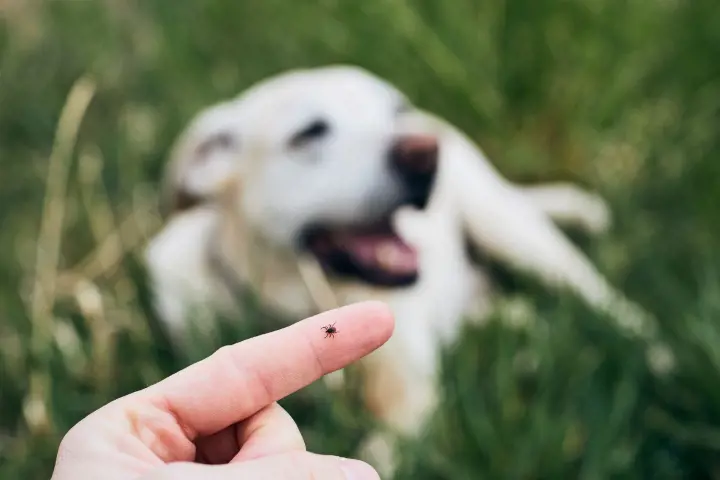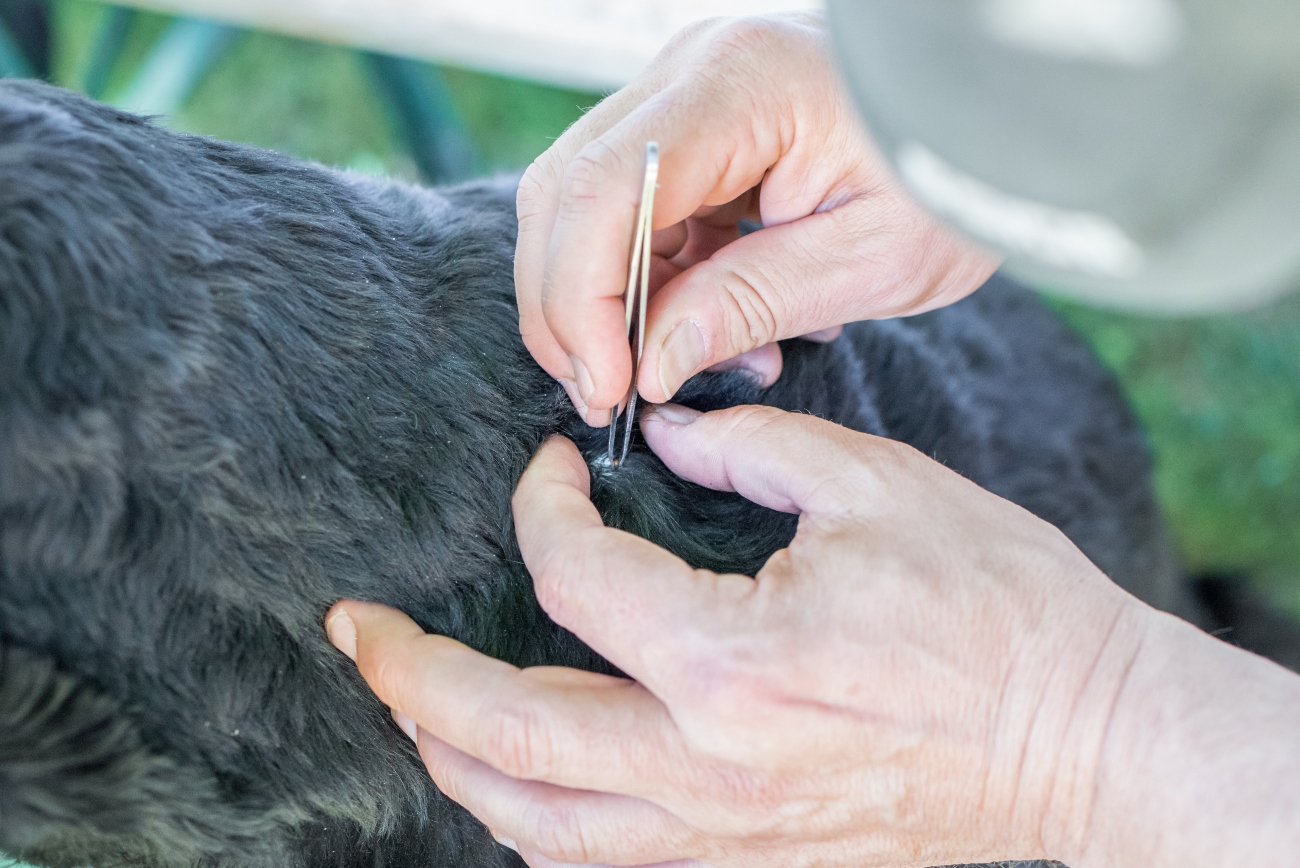Definitive guide on how to remove a tick from a dog
17th July, 2023

Get rid of ticks in a flash! Here’s our ultimate guide on how to protect your pet from these pesky parasites.
There’s nothing better than walking your dog in the great outdoors. But pick up a tick or two and you could soon have a whole host of problems on your hands! Here’s how to rid your pet of the little critters before they cause bigger issues.
We’ll show you how to spot ticks, how to remove them safely and how to protect your pup from other nasties when they’re out and about.
If your canine does fall ill after being bitten by a tick, your animal insurance for dogs should be able to help pick up the tab for emergency treatment.
Here at Purely Pets, we don’t just offer 15 cover levels of animal insurance for dogs, we also have lots of useful articles on our Purely Pets blog. Why not take a look when you’re next searching for animal insurance for dogs?
What are ticks and where could you catch them?
Ticks are a very common parasite found in the UK, often living in woodland and heath areas where weather conditions are warmer and wetter. Popular dog walking areas with heather, bracken, grassland or woodland are generally prime locations for ticks.
Ticks suck the blood of other animals including dogs, cats and us humans. Categorised by scientists as parasitic arachnids, they belong to the spider family and have eight legs and a body that gets larger and darker as they suck more blood. Yuk!
According to Country File, in terms of disease transmission they are placed just behind mosquitos. They’re capable of spreading a number of infectious diseases to both humans and animals, including Lyme disease and babesiosis.
The European Scientific Counsel Companion - Animal Parasites says the ticks most commonly found on dogs are:
- Ixodes Ricinus – sheep or deer tick
- Ixodes hexagonus – hedgehog tick
- Ixodes canisuga – British dog or fox tick
Ticks can live for up to three years and will feed on blood through each of their larvae, nymph and adult life stages. While living on their host, they will also find a mate and reproduce like crazy!
Unlike fleas, they won’t fly or jump on to your pet. Instead, they’ll climb or drop on to your dog’s coat as they brush past.
Ticks are normally pretty lazy in winter, becoming more active during the spring and early summer. Some tick species are active throughout the summer, with a second spike of activity in the cooler autumn.
What is Lyme disease and what are the symptoms in dogs?
Lyme disease is a bacterial tick-transmitted illness caused by a bacteria called Borrelia burgdorferi. This bacterium is transmitted to both humans and animals, such as dogs, through the bite of an infected tick.
It’s important to note that not all ticks are infected with the disease. But Lyme disease is a serious illness in dogs, so it’s important to look out for these common symptoms:
- Joint swelling
- Fever
- Decreased appetite
- Lethargy/fatigue
- Lymph node swelling particularly under the dog’s chin on the sides of the neck
- Recurrent joint or limb pain
- Limping or lameness that comes and goes
Some dogs may not show any signs of the disease whatsoever, while others may have severe symptoms including neurological problems or kidney failure. In the most severe cases, the disease has even been fatal.
If you’ve found a tick on your dog and you suspect they may have Lyme disease, it’s important to consult with your vet for a proper diagnosis and treatment.
For more information on Lyme disease, how it’s diagnosed and treated, read this article from pet food specialist Purina.
What is babesiosis?
Another nasty disease caused by ticks is babesiosis, which destroys red blood cells. While this is still extremely rare in the UK, the tick that spreads it can be found in parts of southern England and Europe and cases are starting to be reported here.
Dogs who have been infected with babesiosis may display the following symptoms:
- Pale gums, lips, eyelids or tongue
- Swollen abdomen
- Fever
- Lack of appetite
- Depression
- Weakness
- Very dark-coloured urine
- Organ failure and even death
Animal charity Blue Cross states that it takes around two weeks for symptoms to appear. Although owing to its rarity some pets have been left undiagnosed for months or even years after infection.
Animal insurance for dogs is vital when dealing with such rare and potentially fatal illnesses as it will ensure your pet gets the care they need as soon as possible. You never want financial worries to get in the way of protecting your faithful hound.
How to look for a tick on a dog
Dogs love spending plenty of time outdoors, so tick checks should be part of your daily pet care routine – particularly during warmer times of the year. But these tiny critters can be difficult to spot if you don’t know what you’re looking for, here’s how to do it.
Conduct a thorough scan of your dog's skin and coat, paying close attention to areas with less fur, such as the inside of their ears, neck and chin, underbelly, between their toes and around their legs.
Use your hands or a comb to gently feel for any small bumps, lumps or swollen areas. Ticks can be small and difficult to see, so it’s important to take your time and be thorough in your examination.
Indeed, before they’ve started feeding, ticks are so tiny they can easily be mistaken for a speck of dirt or a plant seed. Their bodies can become larger and darker once they’re filled with blood, so they can be easier to spot.
An embedded tick on a dog can look like a small, raised bump or lump on the skin, often with a dark centre where the tick's head is buried. The tick's body may be partially visible, but its head is typically underneath the dog's skin.
Even if you haven’t recently spent time in wooded or grassy areas, it’s still important to regularly check your dog for ticks and other parasites. If you notice any changes in your dog’s skin or coat then it’s important to speak to your vet.
How long can a tick stay attached to your dog?

Generally, a tick can stay embedded in your dog for several days to a week or even longer. How long will depend on several factors such as the type of tick, tick life stage, size of the tick and the dog's immune response.
Be aware, the longer a tick remains attached to the dog's skin, the greater the risk of it transmitting a disease. This is why it’s so important to regularly check your dog for ticks and to remove any parasites as soon as possible.
Should I be concerned if I spot a tick on my dog?
Don’t worry too much. Ticks are very common in the UK. And if you spend any time outdoors then you or your furry friend is likely to pick one up at least once.
In the majority of cases a tick bite will do no long-term harm to your pet. However, it’s still important to take ticks seriously, take appropriate measures to remove them, prevent the risk of tick-borne diseases and monitor your dog for any signs of illness.
Can you put something on a tick to get it to drop off?
There are various ‘remedies’ suggested on the Internet that involve painting the tick with chemicals or other substances to get it to detach.
These are not recommended, as doing this can cause the tick to release more harmful bacteria into the bite site and increase the risk of disease transmission, making your pooch even more poorly.
The safest way to remove a tick from a dog is by using a tick-removal tool or a pair of fine-tipped tweezers. If you’re at all unsure of how to properly remove the tick or if the tick appears to be embedded deeply in the skin, it’s always best to consult with your vet.
A key benefit of animal insurance for dogs arranged through Purely Pets is that you’ll get access to our unlimited video consultations. Qualified veterinary professionals are on hand 24/7 to give you advice on everything pet related.
What equipment do you need to remove a tick?
Before removing a tick from your dog, you need to get tooled up!
The Humane Society says you’ll need the following items:
- Clean, fine-tipped tweezers or a tick removal tool
- Isopropyl alcohol
- Antiseptic wipes/cream
- A small container with a lid or a sealable bag (to store the tick for identification)
- Gloves or a tissue to handle the tick
A 7-step guide to removing a tick from your dog
Step 1: Prepare yourself and your pup
Wash your hands thoroughly before starting the tick removal process and get your tick removal kit together. It’s also important to calm your dog and make sure they’re still so they don’t move while the tick is being removed.
Step 2: Locate the tick
Examine your dog's skin carefully to find the tick. If you’re having trouble, use a comb to brush your dog's fur aside to give you a better view.
Step 3: Clean the area
Clean the area with an antiseptic wipe or isopropyl alcohol to help prevent any potential infections.
Step 4: Use the tweezers or tick remover to grasp the tick
Use the fine-tipped tweezers or the tick remover to grasp the tick as close to the dog's skin as possible. Be careful not to squeeze the tick’s body, as this may cause the tick to release saliva or expel blood back into your dog and increase the risk of infection.
Step 5: Remove the tick
If you’re using tweezers, you need to slowly and steadily pull the tick straight up and out of the dog's skin. Don’t twist or jerk the tick, as this may cause its head to break off and remain embedded.
If you’re using a tick removal tool, slide the tool under the tick and then twist the tool in one direction until you feel the tick loosen. Then slowly lift the tool (with the tick attached) away from your pet.
Step 6: Dispose of the tick
After removing the tick, place it in a small container with a lid or a sealable bag and dispose of it properly. It can be a good idea to have the tick identified by a veterinary professional before disposal, just in case your dog develops symptoms of a tick-borne illness.
Step 7: Clean the area
Clean the area where the tick was removed with warm salty water, an antiseptic wipe or isopropyl alcohol to help prevent any potential infections. Monitor your pet for a few days to make sure they’re OK.
How do I tell if a tick’s head is still in my dog’s skin?
Incorrect removal of a tick, such as by pulling, crushing, or squeezing it, can cause it to break apart and leave its head embedded in your dog’s skin. If this has happened to your dog, you should be able to see a small black spot where the tick was attached.
Unfortunately, if part of the tick is left in your dog there is a risk of infection. Signs include heat, redness, swelling and possible discharge at the bite site. Book your dog in for a vet check to make sure.
5 quick tips for preventing ticks
Dealing with ticks is not a pleasant thing to have to do, either for you or your dog. But if you follow these five quick tips then you should be able to prevent ticks from striking.
1. Avoid tick hot-spots
During the warmer months, you’ll probably want to avoid long grass by sticking to paths and other open spaces. If you’re wondering how common ticks are in any new areas you visit this useful tick risk map could help.
2. Use tick treatments
There are various tick treatments available that either kill or repel ticks if they try to attach themselves to your dog. These include spot-on treatments, sprays, collars, and tablets. Talk to your vet about finding the best tick treatment option for your pet.
Blue Cross warns that it’s vital to always read tick treatment instructions carefully. Some treatments are lethal if used on cats. As well as animal insurance for dogs, Purely Pets can also cover your friendly feline, too.
3. Check your dog regularly
Regularly checking your dog for ticks and other nasties is a great habit to get into as it can also help you spot any other skin abnormalities.
4. Keep your garden tidy
Ticks thrive in tall grass and underbrush, so keep your garden trimmed and free of potential homes for ticks.
5. Keep your dog on a lead
When walking in areas where ticks are common, keep your dog on a lead to prevent them from roaming and coming into contact with ticks.
Although animal insurance for dogs can help if your dog strays or is stolen, keeping them on a lead when away from home is also a good idea.
Other parasites your dog could pick up
Ticks aren’t the only enemy of our beloved pooches.
There are several types of parasites worth guarding against, including:
- Fleas: Common parasites that can cause itching, skin irritation, and anaemia in dogs. For more advice on how to get rid of fleas on your dog read this article from the team at Purely Pets.
- Intestinal worms: Roundworms, tapeworms, hookworms and whipworms are all intestinal worms found in dogs in the UK.
- Lungworm: Found in the heart, blood and lungs, they can cause very serious illness and even death.
- Ear mites: Causing itchy, red, waxy ears and sometimes leading to ear infections.
- Nasal mites: Mites living in the nasal passages and sinuses of your dog can cause nose bleeds, sneezing, facial itching, nasal discharge, noisy breathing and affect their ability to pick up scents.
- Sarcoptes mites (mange): Causes intensely itchy, crusty skin, and hair loss.
There’s a wide range of parasites, illnesses and diseases your favourite furry friend could pick up when out and about. Read our A-to-Z guide to dog health problems so you’re well informed.
Because there are more doggy-related ailments than you can shake a stick at, we’ve split the guide into Part 1 covering everything from arthritis to mange, and Part 2 starting with nasal mites and ending with zoonotic viruses. Essential reading!
Going on holiday?
If you decide to take your dog on holiday, the RSPCA warns that some diseases not seen in the UK can be passed by biting insects and ticks when abroad. Before booking your trip, be sure to ask your vet about any preventative treatments your pet might need.
You’ll want to do this well before travelling as some treatments might need to be started well in advance of your holiday. And don’t forget, if your dog becomes ill after being on holiday be sure to let your vet know your dog has been abroad.
Awesome animal insurance for dogs

Even if it’s for something relatively minor, all dogs will require some sort of medical treatment during their lifetime. The problem is that depending on the condition, treatment can be extremely costly – particularly if ongoing medication is required to keep them healthy and pain free.
There’s really no substitute for having the right animal insurance for dogs in place throughout their life. Whatever level of cover you choose, our insurance will go some way to ensuring you don’t have a difficult decision to make due to finances.
Here at Purely Pets, our pet insurance policies are designed to provide cover for a dog’s entire life. Speak to our team and get your animal insurance for dogs in place today.
Helpful Pages
Recent Posts
Pet Insurance Quote
- 98% claims paid *
- Claims paid directly to vets
- 24/7 vet video consultations
- Interest free monthly payments




